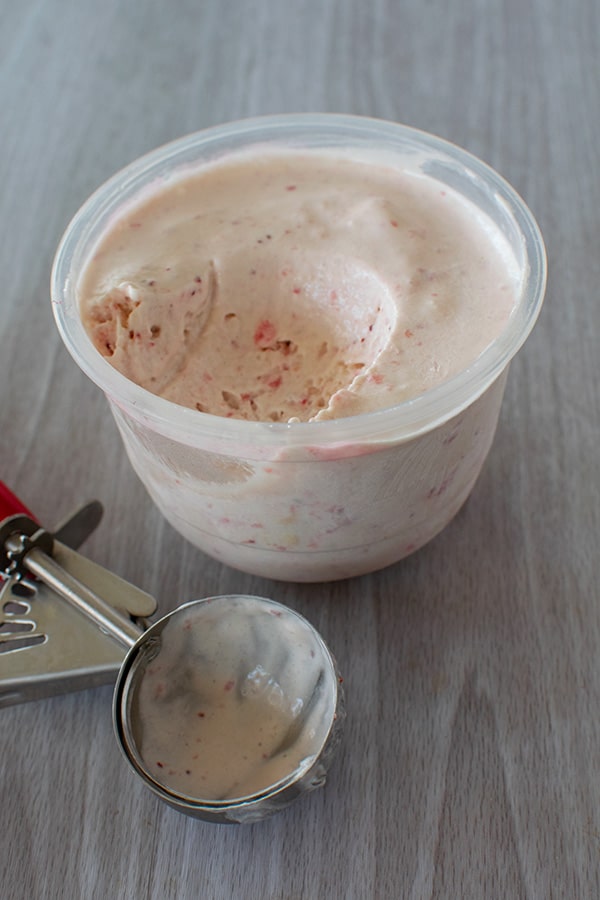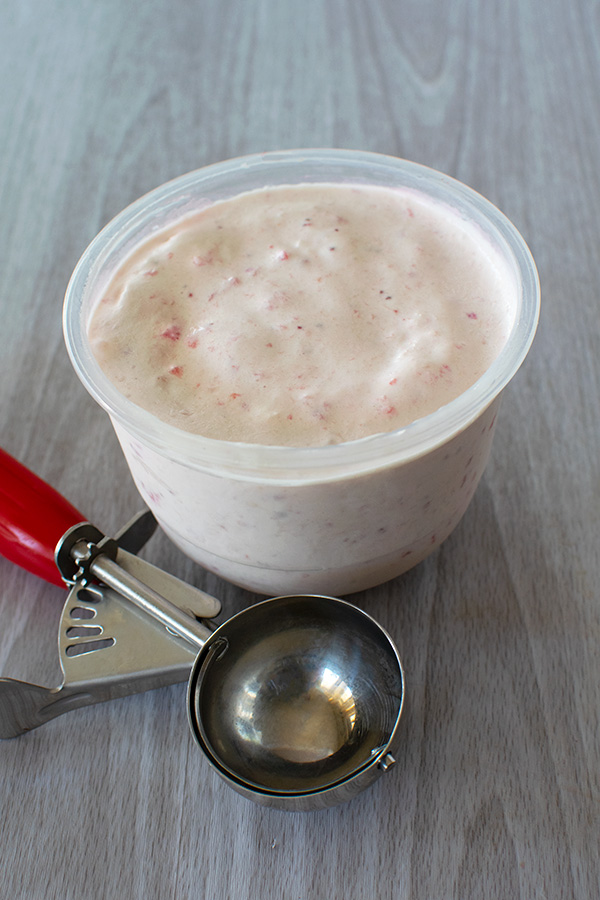Dairy-Free Strawberry Ice Cream is a delicious and simple, no-churn recipe for a homemade soft frozen dessert with only 5 ingredients.

Dairy-Free Strawberry Ice Cream is a soft frozen dessert that is simple to make and can be prepared in a very short amount of time. Just whip it up, freeze, and have it at the ready for a refreshing and delicious treat anytime!
Want to try other flavors?
A little of my cooking background
I really wanted to title this blog “If I can make it, anyone can” because, honestly, if I can make it, anyone can.
I never really liked cooking, and when I was single, a meal for me meant grilled cheese, eggs, tuna, or something else that didn’t require effort or time.
When my kids were young, I was still able to get away with preparing only a small variety of easy meals, but the older they got, the more dishes I learned to make at their request.
Still, I insisted on keeping it simple.
Honestly, I never understood why some cooks unnecessarily complicate meals. I have seen recipes that have several ingredients that don’t really seem to add much, if anything, to the dish. So, why bother?
It has always been important to me that whoever eats at my table will have plenty to enjoy, and that includes my kids (I never agreed with the “You will eat what is served, or you won’t eat” ideology), and, because I keep it simple, I can prepare a variety of dishes in a relatively short period of time.
I have a philosophy regarding being a great cook: Prepare food according to the tastes of those who will be eating it, and they will love your cooking!
As far as I am concerned, start with the basic ingredients that make the dish what it is, adapt according to taste, and voila! You are an amazing cook!
The bottom line is that while there are certainly delicate recipes out there for specialty dishes, making delicious meals doesn’t have to be complicated or time-consuming. It’s not difficult to impress—just make sure it tastes good.
While some of the recipes on my blog are more time-consuming than others, they are all tried and true, easy-shmeezy!
Of course, one always has to consider the conditions under which they cook. Weather (humidity, heat, cold), different types of ovens, different qualities of pots, etc.—all of which can affect your cooking and baking.
Nevertheless, as I said, if I can do it, anyone can!
Everyday pantry essentials (suggested)
As I learned to prepare more and more recipes, I also learned which basics and seasonings are good to have on hand to have the ability to make a dish on short notice and not have to run out to the store or borrow from a neighbor.
While I will admit that I am not always prepared when one of my kids asks for eggplant parmesan or lasagna at the drop of a hat (which they have done), I dislike having to postpone making something just because the ingredients needed to make a reasonable meal were not readily available.
So, I maintain a selection of what I consider “pantry essentials” in my refrigerator and on my shelves at all times.
Initially, many of the herbs and spices were useful to me only on occasion (having been purchased for a particular recipe), and I usually just had them around as leftovers. However, as I began to cook more of a variety, I was really glad to have them (hey, look, I already have that!). And that is how my list began.
While, of course, most of the essentials will not be needed just for any one recipe, at least some of them are needed for most recipes, and you would be surprised how many recipes can be made just with this list. So, if you keep whatever you use regularly on hand, it can really save you time and effort.
Everyone has their favorite recipes, preferred seasonings, and just whatever they like to use to cook. Your own list should certainly reflect your own cooking tastes and style.
Just to give you an idea, the list below is a comprehensive list of what I normally keep on hand (this does not necessarily include what I keep for baking, and there may be some overlap between the two lists as some items are used for both, such as brown sugar), and, of course, it reflects the meals and desserts that I like to make for my own family and guests.
Utensils:
- Measuring cups for liquid
- Measuring cups for solids (flour, sugar, etc.)
- Measuring spoons
- Mixing bowls
- Kitchen scale
NOTE: When using measuring cups and spoons, make sure that the measurements are comparable to one another (example: that 4 tablespoons equals 1/4 of your measuring cup). You’d be surprised to know that not all measuring cups are the same, and this can throw your measurements off.
Seasoning and flavoring:
- salt (my recipes use regular table salt)
- ground black or white pepper
- granulated garlic or garlic powder (I prefer granulated)
- onion powder
- sweet paprika and/or sweet pepper flakes (paprika is ground dried red pepper, pepper flakes are crushed dried red pepper)
- hot paprika, hot pepper flakes, or cayenne pepper (moderately spicy dried ground chili pepper) for those occasional spicy dishes
- ground turmeric
- ground cumin
- ground cinnamon
- ground ginger
- ground nutmeg
- ground cloves (for pumpkin flavors)
- sugar (granulated)
- brown sugar
- chicken consommé powder / beef bouillon powder (regular or vegetarian)
- onion soup mix
- onion flakes (substitute for fresh onion—3 tablespoons for 1 medium onion).
- various herbs
- additional spices to adapt taste to preference
Misc:
- oil / margarine / butter / cooking spray
- coconut cream as a dairy-free cream substitute
- flavorless milk substitute as a dairy-free milk alternative
- cornstarch as a thickening agent
- flour
- baking powder
- baking soda
- bread crumbs or cornflake crumbs (you can make these with your blender or food processor) for coating
- condiments, such as ketchup, mustard, barbecue sauce
- tomato sauce/tomato paste/canned tomatoes—diced or crushed/pasta sauce
- soy sauce
- ready-made pie crusts and dough (to just add filling)
We always have eggs in the fridge and onions, rice, and potatoes on our shelves, as well as pasta.
In addition, having some fresh vegetables in the fridge, such as carrots, celery, tomatoes, bell peppers (various colors), etc., can be very useful when putting together a quick but delicious meal.
It is also a good idea to have some ground meat or chicken (breast, ground, or in parts) in the freezer for anyone who likes meat dishes in a snap.
Weather can have an effect on some of the spices and on the chicken consommé powder, so I keep as many of the seasonings in the refrigerator or freezer as I can, and I keep everything tightly closed in containers (you will be surprised to know just how determined moths are at getting into sealed bags and how hot red pepper powder can attract little black bugs—YUCK!).
Therefore, store your items well.
Why are these pantry essentials beneficial to have on hand?
Personally, having the above ingredients in my kitchen is very advantageous, as I make a variety of dishes and use most of the items on the list regularly enough to warrant storing them. However, I do not store items for dishes that I make seasonally or only on rare occasions or those that spoil easily.
Whether or not it is workable for you depends on your cooking style, the space you have to store, and whether or not you mind running out to the store as needed. Of course, the more you cook and the more varied your recipes, the more you will use and the more you will need.
A little about ice cream
This recipe clearly isn’t “real” ice cream but more of a frozen dessert.
Real ice cream is made by an involved process using milk, milk protein, sugar, ice, water, and air, which turns the mixture into foam as frozen air cells.
Nowadays, we have freezers in which to store our ice cream (and frozen desserts), but before refrigeration, making ice cream took quite a bit of effort and was only served for special events or on special occasions.
Before refrigeration, ice had to be cut from frozen lakes and ponds in the winter. The ice was then stored for later use (even in the summer) in ice houses or even in holes dug in the ground.
The pot-freezer method of preparing ice cream was by making it in a large bowl, which was placed in a tub filled with crushed ice and salt to reduce the temperature of the ingredients to below the freezing point of water.
French confectioners used a method similar to the pot-freezer method but used a covered pail with a handle attached to the lid (called a sorbetiere).
The hand-cranked churn replaced the pot-freezer method and also used ice and salt for cooling. This method was quicker than the pot-freezer method and produced a smoother ice cream.
Ice cream was initially sold by small businesses until a milkman, Jacob Fussell, began making small batches of it from leftover milk and cream. Fussell opened the first ice cream factory in 1851 in Pennsylvania and moved his successful business to Baltimore in 1854.
Fussell, known today as the Father of the Ice Cream Industry, opened more factories in other cities and taught the business to others who opened their own factories. The mass production of ice cream made it more affordable and more accessible to everyone and was no longer a dessert just for the rich.
Popularity increased even more with the invention of the household freezer in the 1920s, when it became much easier to store the frozen dessert.
Ice cream is a beloved dessert, and some people will go to some extreme lengths to get their hands on the treat. For example, during World War II, American fighter pilots in the South Pacific found an ingenious way of making ice cream.
They attached 5-gallon cans to their aircraft. The cans were fitted with small propellers spun by the slipstream, which drove a stirrer, which agitated the mixture, which froze in the high altitude of the planes as they flew. B-17 crews and others found similar methods of making ice cream during the war.
Today, getting ice cream is simple and inexpensive, and the flavors are numerous. Many households have their own ice cream machines for at-home preparation.
Dairy-Free Strawberry Ice Cream is more of a frozen dessert than “real” ice cream, but it is easy to make and delicious.
Dairy-Free Strawberry Ice Cream

Easy homemade no-churn, no-cook soft strawberry ice cream.
Ingredients
- 1 8-ounce container of dairy free whipping cream
- 6 - 8 ounces ripe or frozen strawberries
- 3 eggs
- 1/2 c sugar
- 1 teaspoon vanilla or to taste
Instructions
- Whip whipping cream until stiff.
- Blend strawberries in a blender.
- Add blended strawberries, eggs, sugar, and vanilla into the whipped cream.
- Whip together well.
- Freeze for 8 hours or until stiff *
Notes
* This is a soft ice cream so it won't get hard and the freezing time depends on your freezer.
Nutrition Information:
Yield:
4Serving Size:
1Amount Per Serving: Calories: 476Total Fat: 25gSaturated Fat: 15gTrans Fat: 1gUnsaturated Fat: 9gCholesterol: 207mgSodium: 76mgCarbohydrates: 58gFiber: 7gSugar: 43gProtein: 8g